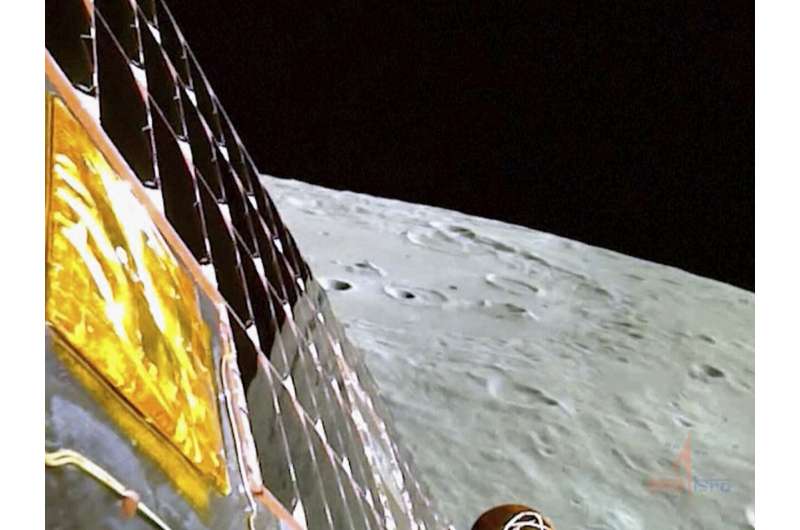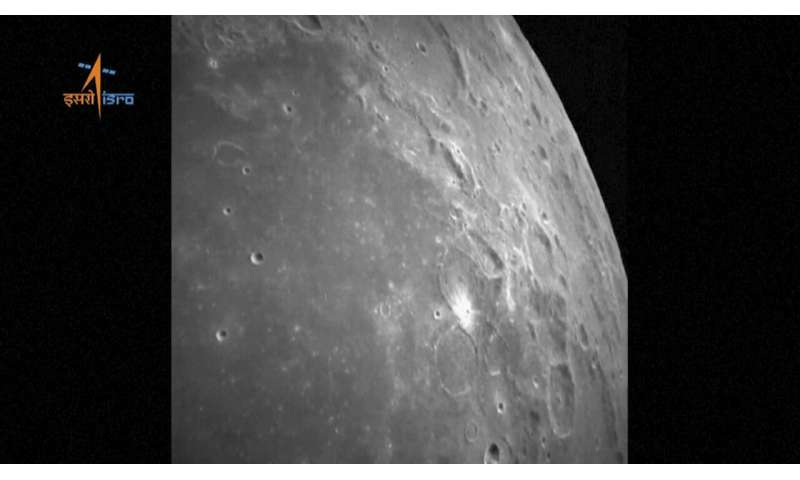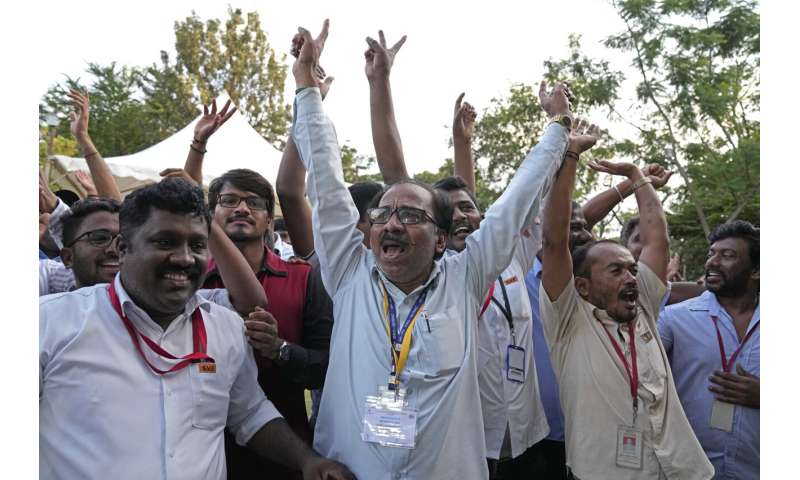This article has been reviewed according to Science X's editorial process and policies. Editors have highlighted the following attributes while ensuring the content's credibility:
fact-checked
reputable news agency
proofread
India's lunar rover goes down a ramp to the moon's surface and takes a walk

A lunar rover slid down a ramp from the lander of India's spacecraft within hours of its historic touch-down near the moon's south pole, Indian space officials said Thursday, as the country celebrated its new scientific accomplishment.
"India took a walk on the moon," the state-run Indian Space Research Organization said, adding that the Chandrayan-3 Rover would conduct experiments over 14 days, including an analysis of the mineral composition of the lunar surface.
Residents of the world's most populous country had crowded around televisions in offices, shops, and restaurants on Wednesday and erupted into clapping, dancing, and exchanging of sweets when they saw the lander's smooth touchdown. It landed on uncharted territory that scientists believe could hold vital reserves of frozen water.
''India Goes Where No Nation's Gone Before,'' read Thursday's headline in The Times of India daily, while the Indian Express newspaper exclaimed, "The moon is Indian."
Ajay Bhargava, a New Delhi-based architect, said it was a great experience watching broadcasts of the landing, and that he felt it was the culmination of hard work by India's scientists over the years.
''Prime Minister Narendra Modi or any other politician should not take credit for this achievement," Bhargava said in a telephone interview.

Indian Space Research Organization Chairman S. Somnath said the lander had touched down close to the center of the 4.5-kilometer-wide (2.8-mile-wide) area that had been targeted for the landing. "It landed within 300 meters (985 feet) of that point," the Press Trust of India cited him as saying.
The rover was on the move, and working ''very well," Somnath said.
Somnath said there are two scientific instruments in the rover and three instruments on board the lander, and all of them have been switched on sequentially.
"They will study basically the mineral composition of the moon, as well as the atmosphere of the moon and the seismic activities there," he added.
After a failed attempt to land on the moon in 2019, India on Wednesday joined the United States, the Soviet Union and China as only the fourth country to achieve this milestone.
-

Schoolchildren cheer as they watch the successful landing of Chandrayaan-3, or “moon craft” in Sanskrit, at the Nehru Planetarium in New Delhi, India, Wednesday, Aug. 23, 2023. India has landed a spacecraft near the moon’s south pole, an unchartered territory that scientists believe could hold vital reserves of frozen water and precious elements, as the country cements its growing prowess in space and technology. Credit: AP Photo/Manish Swarup -

This image from video provided by the Indian Space Research Organisation shows the surface of the moon as the Chandrayaan-3 spacecraft prepares for landing on Wednesday, Aug. 23, 2023. India became the first country to land a spacecraft near the moon’s south pole, which scientists believe could hold vital reserves of frozen water. Credit: ISRO via AP -

Schoolchildren celebrate the successful landing of spacecraft Chandrayaan-3 on the moon, in a school in Guwahati, India, Wednesday, Aug. 23, 2023. India has landed a spacecraft near the moon's south pole, an unchartered territory that scientists believe could hold vital reserves of frozen water and precious elements, as the country cements its growing prowess in space and technology. Credit: AP Photo/Anupam Nath -

Indian Space Research Organization (ISRO) staff celebrate the successful landing of spacecraft Chandrayaan-3 on the moon at ISRO's Telemetry, Tracking and Command Network facility in Bengaluru, India, Wednesday, Aug. 23, 2023. India has landed a spacecraft near the moon's south pole, an unchartered territory that scientists believe could hold vital reserves of frozen water and precious elements, as the country cements its growing prowess in space and technology.Credit: AP Photo/Aijaz Rahi
The successful mission showcases India's rising standing as a technology and space powerhouse and dovetails with the image that Modi is trying to project: an ascendant country asserting its place among the global elite.
The mission began more than a month ago at an estimated cost of $75 million. Somnath said that India would next attempt a manned lunar mission.
Many countries and private companies are interested in the South Pole region because its permanently shadowed craters may hold frozen water that could help future astronaut missions, as a potential source of drinking water or to make rocket fuel.
India's success comes just days after Russia's Luna-25, which was aiming for the same lunar region, spun into an uncontrolled orbit and crashed. It would have been the first successful Russian lunar landing after a gap of 47 years. Russia's head of the state-controlled space corporation Roscosmos attributed the failure to the lack of expertise due to the long break in lunar research that followed the last Soviet mission to the moon in 1976.
Active since the 1960s, India has launched satellites for itself and other countries, and successfully put one in orbit around Mars in 2014. India is planning its first mission to the International Space Station next year, in collaboration with the United States.
© 2023 The Associated Press. All rights reserved. This material may not be published, broadcast, rewritten or redistributed without permission.





















